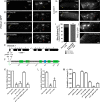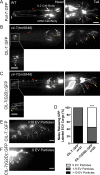Myristoylated CIL-7 regulates ciliary extracellular vesicle biogenesis
- PMID: 26041936
- PMCID: PMC4571341
- DOI: 10.1091/mbc.E15-01-0009
Myristoylated CIL-7 regulates ciliary extracellular vesicle biogenesis
Abstract
The cilium both releases and binds to extracellular vesicles (EVs). EVs may be used by cells as a form of intercellular communication and mediate a broad range of physiological and pathological processes. The mammalian polycystins (PCs) localize to cilia, as well as to urinary EVs released from renal epithelial cells. PC ciliary trafficking defects may be an underlying cause of autosomal dominant polycystic kidney disease (PKD), and ciliary-EV interactions have been proposed to play a central role in the biology of PKD. In Caenorhabditis elegans and mammals, PC1 and PC2 act in the same genetic pathway, act in a sensory capacity, localize to cilia, and are contained in secreted EVs, suggesting ancient conservation. However, the relationship between cilia and EVs and the mechanisms generating PC-containing EVs remain an enigma. In a forward genetic screen for regulators of C. elegans PKD-2 ciliary localization, we identified CIL-7, a myristoylated protein that regulates EV biogenesis. Loss of CIL-7 results in male mating behavioral defects, excessive accumulation of EVs in the lumen of the cephalic sensory organ, and failure to release PKD-2::GFP-containing EVs to the environment. Fatty acylation, such as myristoylation and palmitoylation, targets proteins to cilia and flagella. The CIL-7 myristoylation motif is essential for CIL-7 function and for targeting CIL-7 to EVs. C. elegans is a powerful model with which to study ciliary EV biogenesis in vivo and identify cis-targeting motifs such as myristoylation that are necessary for EV-cargo association and function.
© 2015 Maguire et al. This article is distributed by The American Society for Cell Biology under license from the author(s). Two months after publication it is available to the public under an Attribution–Noncommercial–Share Alike 3.0 Unported Creative Commons License (http://creativecommons.org/licenses/by-nc-sa/3.0).
Figures




References
-
- Bae YK, Qin H, Knobel KM, Hu J, Rosenbaum JL, Barr MM. General and cell-type specific mechanisms target TRPP2/PKD-2 to cilia. Development. 2006;133:3859–3870. - PubMed
Publication types
MeSH terms
Substances
Grants and funding
LinkOut - more resources
Full Text Sources
Molecular Biology Databases
Research Materials
Miscellaneous

